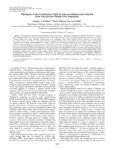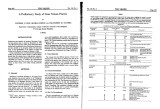|
|
Creator | Title | Description | Subject | Date |
| 476 |
 |
Bohs, Lynn A. | Phylogeny of the carolinense clade of solanum (Solanaceae) inferred from nuclear and plastid DNA sequences | The large and economically important genus Solanum contains ca. 1,400 species distributed worldwide. One of the 12-14 major clades identified in the genus is the Leptostemonum clade, or the "spiny solanums." Previous molecular phylogenetic studies have identified 14 major clades in the spiny solanum... | | 2014-01-01 |
| 477 |
 |
Bohs, Lynn A. | Phylogeny of the Cyphomandra clade of the genus Solanum (Solanaceae) based on ITS sequence data | 13 major clades can be recognized within the genus Solatium (Solanaceae) based on chloroplast DNA sequence data. One of these is the Cyphomandra clade, which includes about 50 neotropical species. These have traditionally been placed into two or three sections: S. section Pachyphylla (formerly recog... | Cyphomandra; ITS; osmophores; self-incompatibility; Solanum | 2007 |
| 478 |
 |
Goller, Franz | Physiologically driven avian vocal synthesizer | In this work, we build an electronic syrinx, i.e., a programmable electronic device capable of integrating biomechanical model equations for the avian vocal organ in order to synthesize song. This vocal prosthesis is controlled by the bird's neural instructions to respiratory and the syringeal mot... | | 2010-03 |
| 479 |
 |
Ehleringer, James R. | Plant adaptation in the Great Basin and Colorado Plateau | Adaptive features of plants of the Great Basin are reviewed. The combination of cold winters and an arid to semiarid precipitation regime results in the distinguishing features of the vegetation in the Great Basin and Colorado Plateau. The primary effects of these climatic features arise from how t... | Plant adaptation; Great Basin; Colorado Plateau; Cold deserts | 1992 |
| 480 |
 |
Adler, Frederick R. | Plant signalling: The opportunities and dangers of chemical communication | The notion of chemical communication between plants and other organisms has gone from being viewed as a fringe idea to an accepted ecological phenomenon only recently. An Organized Oral Session at the August 2010 Ecological Society of America meeting in Pittsburgh examined the role of plant signall... | | 2011 |
| 481 |
 |
Olivera, Baldomero M. | Poly (ADP-ribosylation) in Vitro: reaction parameters and enzyme mechanism | The reaction catalyzed by poly(ADP-ribose) synthetase from bovine thymus was investigated using the purified enzyme, calf thymus DNA, and histone H1. The rate and extent of poly(ADP-ribosylation), as well as the spectrum of acceptor proteins, changed as reaction conditions were varied. The ionic co... | ADP-ribosylation; Poly(ADP-ribose) synthetase; Histone H1 | 1982 |
| 482 |
 |
Olivera, Baldomero M. | Poly(ADP-ribosylation) of a DNA topoisomerase | A DNA topoisomerase activity, copurifying with poly(ADP-ribose) synthetase from calf thymus, >95% inhibited if extensive poly(ADP-ribosylation) is allowed to occur. The inhibited DNA topoisomerase, which has drastically different elution properties on hydroxylapatite, can be reactivated by mild alka... | Nicotinic acid; ADP-ribosylation; Turnover cycle; Synthetases | 1983 |
| 483 |
 |
Olivera, Baldomero M. | Poly(ADP-ribosylation) of DNA topoisomerase I from calf thymus | We demonstrate that the activity of the major DNA topoisomerase I from calf thymus is severely inhibited after modification by purified poly(ADP-ribose) synthetase. Polymeric chains of poly(ADP-ribose) are covalently attached to DNA topoisomerase I. These observations with highly purified enzymes ... | ADP-ribosylation; Poly(ADP-ribose) synthetase | 1984 |
| 484 |
 |
Olivera, Baldomero M. | Poly(ADP-ribosylation) of DNA topoisomerase I: a nuclear response to DNA-strand interruptions | DNA in eukaryotic chromosomes is organized differently from prokaryotic DNA. It seems highly probable that mechanistic adjustments have been made in macromolecular DNA metabolism as a consequence of the chromatin structure of the eukaryotic chromosome (Igo-Kemenes et al. 1982)). This paper deals ... | Poly(ADP-ribosylation); Poly(ADP-ribose) synthetase; DNA strand interruption | 1984 |
| 485 |
 |
Capecchi, Mario R. | Polypeptide chain termination in vitro: isolation of a release factor. | The growing polypeptide chain remains bound to the ribosome-messenger RNA complex through the sRNA carrying the last amino acid incorporated into the polypeptide chain.' On completion of the polypeptide chain a mechanism must exist for releasing it from the protein-synthesizing machinery. To date, m... | Carbon Isotopes; Phenylalanine; Proteins | 1967-09-01 |
| 486 |
 |
Capecchi, Mario R. | Polypetide chain termination. Purification of the release factors, R1 and R2, from Escherichia coli. | We have extensively purified the release factors RI and Rz from Escherichia coli. These proteins can each mediate polypeptide chain termination. The physiological substrate for this reaction is a completed polypeptide chain in a peptidyl- transfer RNA-messenger RNA-ribosome complex. The reaction con... | Acrylates; Detergents | 1971-02-25 |
| 487 |
 |
Ehleringer, James R. | Population- and family-level variation of brittlebush (Encelia farinosa, Asteraceae) pubescence: its relation to drought and implications for selection in variable environments | Because leaf pubescence of the desert shrub Encelia farinosa increases in response to drought and influences photosynthesis and transpiration, we hypothesized that differences in water availability across the range of this species may result in genetic differentiation for pubescence and associated p... | Encelia farinose; Absorptance; Adaptation; Asteraceae; Desert; Drought acclimation; Leaf pubescence; maternal family variance; spatiotemporal heterogeneity | 2003 |
| 488 |
 |
Olivera, Baldomero M.; Yoshikami, Doju; Bulaj, Grzegorz | Post-translational amino acid isomerization: a functionally important D-amino acid in an excitatory peptide | The post-translational modification of an L- to a D-amino acid has been documented in relatively few gene products, mostly in small peptides under 10 amino acids in length. In this report, we demonstrate that a 46-amino acid polypeptide toxin has one D-phenylalanine at position 44, and that the ... | D-amino acid; Excitatory peptides; Conotoxins | 2005 |
| 489 |
 |
Ehleringer, James R. | Potential adaptability and constraints of response to changing climates for Encelia farinosa var. phenicodonta from southern Baja California, Mexico | To examine the physiological adaptability of Encelia farinosa var. phenicodonta from southern Baja California, plants from Todos Santos, BCS were raised in central Arizona where winter-spring precipitation is greater than typically experienced by this variety. Plants were capable of high photosynthe... | Encelia farinosa var. phenicodonta; Ecophysiology | 1996 |
| 490 |
 |
Olivera, Baldomero M. | Preliminary study of Conus venom protein | ALTHOUGH THE TOXICITY of venoms of the genus Conus has been known since a report by RUMPHIUS in 1705 (VAN BENTHEM-JUTTINO, 1959), these venoms have been studied only intermittently since. Biochemical studies have not been carried out to any great extent; the last major study on the biochemistry of... | Conotoxins; Conus venom | 1976 |
| 491 |
 |
Davidson, Diane W. | Preliminary study of seed predation in desert and montane habitats | Multifactorial experiments in which domestic seeds in shallow glass containers were distributed in desert and montane habitats provided data on identity of seed predators (whether rodents or ants), spatial and temporal pattern of their foraging activities, and their preferences for sizes and species... | Ant; Competition; Granivory; Predators, Seed; Rodent; Seed selection | 1975 |
| 492 |
 |
Gesteland, Raymond F.; Atkins, John F.; Felden, Brice; McCutcheon, John P. | Probing the structure of the Escherichia coli 10Sa RNA (tmRNA) | The conformation of the Escherichia coli 10Sa RNA (tmRNA) in solution was investigated using chemical and enzymatic probes. Single- and double-stranded domains were identified by hydrolysis of tmRNA in imidazole buffer and by lead(II)-induced cleavages. Ribonucleases T1 and S1 were used to map unpai... | Covariation; Pseudoknot; Structural Probing; 10Sa RNA; tmRNA | 1997 |
| 493 |
 |
Gesteland, Raymond F. | Processing of adenovirus 2-induced proteins | Analysis of (35)S-methionine-labeled extracts of adenovirus 2-infected KB cells revealed 22 virus-induced polypeptide components. Most proteins of the virion were easily detected in extracts of whole cells labeled for short periods between 15 and 30 h after infection; however, several virion compone... | Adenoviridae; Viral Proteins; Protein Precursors; Methionine; Mouth Neoplasms | 1973 |
| 494 |
 |
Capecchi, Mario R. | Production of selenoprotein P (Sepp1) by hepatocytes is central to selenium homeostasis | Background: Sepp1 transports selenium, but its complete role in selenium homeostasis is not known. Results: Deletion of Sepp1 in hepatocytes increases liver selenium at the expense of other tissues and decreases whole-bodyselenium by increasing excretion. Conclusion: Sepp1 production by hepatocytes ... | | 2012-01-01 |
| 495 |
 |
Sekercioglu, Cagan | Promoting community-based bird monitoring in the tropics: conservation, research, environmental education, capacity-building, and local incomes | Long-term, locally-based biodiversity monitoring programs are essential for understanding and mitigating the effects of global change on tropical biodiversity while providing capacity-building, environmental education, and public outreach. However, these programs are lacking in most tropical countri... | | 2011-01-01 |
| 496 |
 |
Goller, Franz | Prosthetic Avian vocal organ controlled by a freely behaving bird based on a low dimensional model of the biomechanical periphery | Because of the parallels found with human language production and acquisition, birdsong is an ideal animal model to study general mechanisms underlying complex, learned motor behavior. The rich and diverse vocalizations of songbirds emerge as a result of the interaction between a pattern generator i... | | 2012-01-01 |
| 497 |
 |
Jorgensen, Erik | Protein localization in electron micrographs using fluorescence nanoscopy | A complete portrait of a cell requires a detailed description of its molecular topography: proteins must be linked to particular organelles. Immuno-electron microscopy can reveal locations of proteins with nanometer resolution but is limited by the quality of fixation, the paucity of antibodies, and... | | 2010-01-01 |
| 498 |
 |
Gussin, Gary N.; Capecchi, Mario R. | Protein synthesis directed by DNA phage messengers. | Even through the amino acids corresponding to most of the 64 nucleotide triplets are now known, several important aspects of the genetic code are not yet fully understood. In particular we need more knowledge about the "punctuation marks" of the code-for example, the signals necessary for the initia... | Carbon Isotopes; Escherichia coli; Genetic Code; Methionine | 1967-09-01 |
| 499 |
 |
Farmer, Colleen G. | The provenance of alveolar and parabronchial lungs: insights from paleoecology and the discovery of cardiogenic, unidirectional airflow in the American alligator (Alligator mississippiensis) | Birds and mammals evolved greater aerobic abilities than their common ancestor had. This required expansion of the cardiopulmonary system's capacity for gas exchange, but while directional selection for his expanded capacity resulted in extremely similar avian and mammalian hearts, strikingly differ... | | 2010-07 |
| 500 |
 |
Davidson, Diane W. | Pruning of host plant neighbors by ants: an experimental approach | Some ants of myrmecophytic plants either obligately or facultatively prune vegetation surrounding their host trees. Pruning behavior occurs at higher frequency in ants with sting defenses than in those with chemical defenses, which may generally convey an advantage in aggressive encounters between a... | Allelopathy; Allomerus demararae; Ant-plant interactions; Ants; Cordia nodosa; Crematogaster; Mutualism; Peru; Plant-animal interaction; Pseudomyrmex; Triplaris americana | 1988 |

























